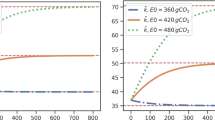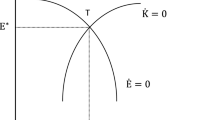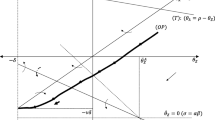Abstract
In an endogenous growth model with human capital accumulation, we introduce non-renewable resources which cause flow pollution problems. In this set-up the negative external effect of pollution on productivity does not cause any distortions in the economy: The market economy will achieve the optimal extraction and growth rates. Consequently, emission taxes are unnecessary and, when introduced, will have no effect on the economy. The more important is the negative pollution externality, the larger will be the optimal long-run growth rate (which may be either positive or negative). In the case of a positive human capital externality, consumption in the market economy may approach zero in the long run, although positive consumption growth is socially optimal. Growth-enhancing policies do not necessarily cause a larger drain in the resource stock.
Similar content being viewed by others
References
Amundsen, E. and R. Schöb (1996), Environmental Taxes on Exhaustible Resources, Working Paper no. 1396. University of Bergen.
Bovenberg, A. L. and Sjak Smulders (1995), ‘Environmental Quality and Pollution-Augmenting Technological Change in a Two-Sector Endogenous Growth Model’, Journal of Public Economics 57, 369-391.
Dasgupta, Partha and Geoffrey Heal (1979), Economic Theory and Exhaustible Resources. Nisbet: Cambridge University Press.
Elbasha, Elamin and Terry L. Roe (1996), ‘On Endogenous Growth: The Implications of Environmental Externalities’, Journal of Environmental Economics and Management 31, 240-268.
Farzin, Y. H. and O. Tahvonen (1996), ‘Global Carbon Cycle and the Optimal Time Path of a Carbon Tax’, Oxford Economic Papers 48, 515-536.
Gradus, R. and Sjak Smulders (1993), ‘The Trade-Off Between Environmental Care and Long-term Growth — Pollution in Three Prototype Growth Models’, Journal of Economics 58, 25-51.
Hettich, F. (1998), ‘Growth Effects of a Revenue-Neutral Environmental Tax Reform’, Journal of Economics 67, 287-316.
Kolstad, Charles E. and Jeffrey A. Krautkraemer (1993), ‘Natural Resource Use and the Environment’, in Kneese and Sweeney, eds., Handbook of Natural Resource and Energy Economics 3. Elsevier.
Lucas, R. E. (1988), ‘On the Mechanics of Economic Development’, Journal of Monetary Economics 22, 3-42.
Nielsen, Søren Bo, Lars Haagen Pedersen and Peter Birch Sørensen (1995), ‘Environmental Policy, Pollution, Unemployment, and Endogenous Growth’, International Tax and Public Finance 2, 185-205.
Robson, A. J. (1980) ‘Costly Innovation and Natural Resources’, International Economic Review 21, 17-30.
Rosendahl, K. E. (1997), ‘Does Improved Environmental Policy Enhance Economic Growth?’, Environmental and Resource Economics 9, 341-364.
Scholz, Christian M. and Georg Ziemes (1996), ‘Exhaustible Resources, Monopolistic Competition, and Endogenous Growth’. Mimeo, University of Kiel.
Schou, P. (1995), Naturresurser og Endogen Vaekst(Natural Resources and Endogenous Growth). Unpublished manuscript, University of Copenhagen.
Sinclair, P. (1994), ‘On the Optimum Trend of Fossil Fuel Taxation’, Oxford Economic Papers 46, 869-877.
Smulders, S. and Raymond Gradus (1996), ‘Pollution Abatement and Long-term Growth’, European Journal of Political Economy 12, 505-532.
Stiglitz, J. (1974), ‘Growth with Exhaustible Natural Resources: Efficient and Optimal Growth Paths’, Review of Economic Studies 41(Symposium), 123-137.
Stokey, N. (1998), ‘Are There Limits to Growth?’, International Economic Review 39, 1-31.
Takayama, A. (1980), ‘Optimal Technical Progress with Exhaustible Resources’, in Kemp and Long, eds., Exhaustible Resources, Optimality, and Trade. Amsterdam: North-Holland.
Ulph, A. and D. Ulph (1994), ‘The Optimal Time Path of a Carbon Tax’, Oxford Economic Papers 46, 857-868.
Uzawa, H. (1965), ‘Optimum Technical Change in an Aggregative Model of Economic Growth,’ International Economic Review 618-31.
Author information
Authors and Affiliations
Rights and permissions
About this article
Cite this article
Schou, P. Polluting Non-Renewable Resources and Growth. Environmental and Resource Economics 16, 211–227 (2000). https://doi.org/10.1023/A:1008359225189
Issue Date:
DOI: https://doi.org/10.1023/A:1008359225189




